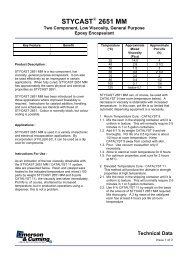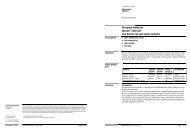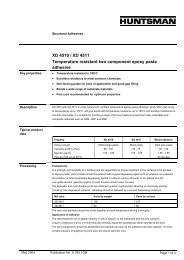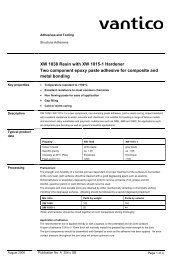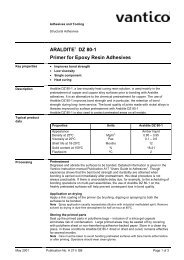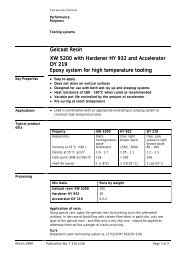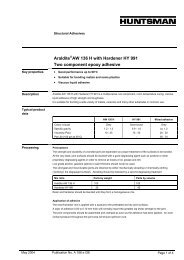Aerospace Adhesives Araldite 403 A/B Two component epoxy paste ...
Aerospace Adhesives Araldite 403 A/B Two component epoxy paste ...
Aerospace Adhesives Araldite 403 A/B Two component epoxy paste ...
You also want an ePaper? Increase the reach of your titles
YUMPU automatically turns print PDFs into web optimized ePapers that Google loves.
<strong>Adhesives</strong> andToolingStructural <strong>Adhesives</strong><strong>Aerospace</strong> <strong>Adhesives</strong><strong>Araldite</strong> ® <strong>403</strong> A/B<strong>Two</strong> <strong>component</strong> <strong>epoxy</strong> <strong>paste</strong> adhesiveKey properties• <strong>Two</strong> part cold cured system• Can be used in conjunction with riveting• Good strength retention up to 120°CDescription<strong>Araldite</strong> <strong>403</strong> A/B is a two pack cold curing structural adhesive system developed primarilyfor use in riveted joints to give improved fatigue resistance. It also gives other benefits ofbonded assembly to structural joints which cannot be bonded with hot cured adhesivesbecause of their size or other physical limitations. It is also suitable for honeycomb-to-skinbonding. For evaluation purposes <strong>Araldite</strong> <strong>403</strong> (cold cured) has been tested in unrivetedmetal-to-metal joints and has been found to meet all the requirements of U.S FederalSpecification MMM-A-132 as a Type 1, Class 3 adhesive.Typical productdataProperty <strong>Araldite</strong> <strong>403</strong> A <strong>Araldite</strong> <strong>403</strong> B MixedColour (visual) grey blue greySpecific gravity 1.3 - 1.4 0.8 - 0.9 1.5 - 1.6Viscosity at 25°C (Pas) 1200 - 1700 0.01 - 0.02 ca. 150Pot life (100 gm at 25°C) mins - - 60 - 90ProcessingPretreatmentThe strength and durability of a bonded joint are dependant on proper treatment of thesurfaces to be bonded.At the very least, joint surfaces should be cleaned with a good degreasing agent such asacetone, trichloroethylene or proprietary degreasing agent in order to remove all traces ofoil, grease and dirt. Alcohol, gasoline (petrol) or paint thinners should never be used.The strongest and most durable joints are obtained by either mechanically abrading orchemically etching (“pickling”) the degreased surfaces. Abrading should be followed by asecond degreasing treatment.July 2000 Publication No. A 152 c GB Page 1 of 4
Mix ratio Parts by weight Parts by volume<strong>Araldite</strong> <strong>403</strong> A 100 -<strong>Araldite</strong> <strong>403</strong> B 7.5 -The resin and hardener should be blended until they form a homogeneous mix.Pot lifeTo obtain the maximum workable life after mixing, pour the adhesive into a shallow tray toa maximum depth of about 6mm. This will assist rapid dissipation of heat generation byexothermic reaction. The workable life will then be approximately 1½hours at 25°C. Thiswill be reduced at higher temperatures, or may be increased by maintaining a lowertemperature.Application of adhesive<strong>Araldite</strong> <strong>403</strong> may be applied by extrusion or by spreading with a roller or serrated combspreader. Apply a thin coating of the adhesive to each surface of the joint; for honeycombto-skinbonds apply the adhesive to the honeycomb surface and to the skins.AssemblyThe joint assembly must be completed and securely clamped or tack riveted within 2 hoursof mixing the adhesive. <strong>Araldite</strong> <strong>403</strong> has excellent gap-filling properties and is tolerant ofglue-line thickness variations over the range 0.08 - 0.80mm.Riveting<strong>Araldite</strong> <strong>403</strong> does not appear to be sensitive to riveting operations, but there is a risk thatthe joint may be disturbed if the assembly is moved during the most critical part of theadhesive curing period. All riveting should be done before the adhesive has set or after ithas hardened sufficiently to withstand normal handling. Unless the assembly is rigidlyclamped in a jig to prevent movement, riveting should only be done during the 6 hoursimmediately following adhesive application; alternatively, the assembly should be leftundisturbed for at least 24 hours after clamping or tack riveting before further work iscarried out on it.Equipment maintenanceAll tools should be cleaned before adhesives residues have had time to cure. The removalof cured residues is a difficult and time-consuming operation.If solvents such as acetone are used for cleaning, operatives should take the appropriateprecautions and, in addition, avoid skin and eye contact.CuringAt 22°C <strong>Araldite</strong> <strong>403</strong> will attain 50% of its ultimate strength approximately 2 days aftermixing, 80-90% of its full strength after 1 week, and full strength after about 8 weeks.Where circumstances permit, curing time can be reduced to 16 hours by warming theassembly to 45 ± 5°C.July 2000 Publication No. A 152 c GB Page 2 of 4
Typical curedpropertiesThe following data has been obtained for <strong>Araldite</strong> <strong>403</strong> on tensile lap shear specimens madeand tested in the manner described in the U.S. specification MMM-A-132.The figures were determined with typical production batches using standard testingmethods. They are provided solely as technical information and do not constitute a productspecification.Tensile shear strength : effect on fluid immersionsCure: 42 days at 22°C, test specification MMM-A-1327 days 30 daysStd. test fluid / 24°CHydraulic oil / 24°CAnti-icing fluid / 24°CJP 4 / 24°CTap water / 24°C100% RH / 49°CSalt spay / 35°CN/mm 20 5 10 15 20 25 30Lap shear strength versus temperature (ISO 4587) (typical average values)Cure: 42 days at 22°CN/mm 2<strong>403</strong>02010°C0-55 -30 -20 0 20 40 60 80 100 120StorageHandlingprecautions<strong>Araldite</strong> <strong>403</strong> A/B may be stored for up to 3 years at 2-40°C, provided the <strong>component</strong>s arestored in their original sealed containers. The expiry date is indicated on the label.CautionVantico products are generally quite harmless to handle provided that certain precautionsnormally taken when handling chemicals are observed. The uncured materials must not, forinstance, be allowed to come into contact with foodstuffs or food utensils, and measuresshould be taken to prevent the uncured materials from coming in contact with the skin, sincepeople with particularly sensitive skin may be affected. The wearing of impervious rubber orplastic gloves will normally be necessary; likewise the use of eye protection. The skinshould be thoroughly cleansed at the end of each working period by washing with soap andwarm water. The use of solvents is to be avoided. Disposable paper - not cloth towels -should be used to dry the skin. Adequate ventilation of the working area is recommended.These precautions are described in greater detail in Vantico publication No. 24264/3/eHygienic precautions for handling plastics products of Vantico and in the Vantico MaterialSafety Data sheets for the individual products. These publications are available on requestand should be referred to for fuller information.July 2000 Publication No. A 152 c GB Page 3 of 4
Vantico Limited<strong>Adhesives</strong> and ToolingAll recommendations for the use of our products, whether given by us in writing, verbally, or to be implied from the results of testscarried out by us, are based on the current state of our knowledge. Notwithstanding any such recommendations the Buyer shallremain responsible for satisfying himself that the products as supplied by us are suitable for his intended process or purpose.Since we cannot control the application, use or processing of the products, we cannot accept responsibility therefor. The Buyershall ensure that the intended use of the products will not infringe any third party’s intellectual property rights. We warrant that ourproducts are free from defects in accordance with and subject to our general conditions of supply.Duxford, CambridgeEngland CB2 4QA© VanticoLtd, 2000® <strong>Araldite</strong> is a registered trademark of Vantico AG, Basel, SwitzerlandTel: +44 (0) 1223 832121Fax: +44 (0) 1223 493322www.vantico.comJuly 2000 Publication No. A 152 c GB Page 4 of 4



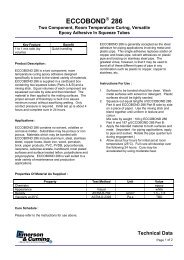
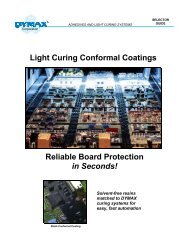

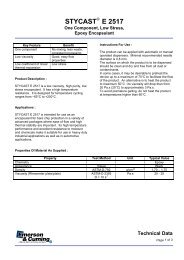
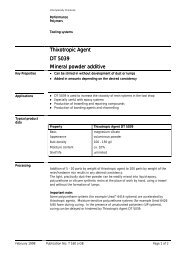
![[pdf] EXXON-TF56-TD - Lindberg & Lund AS](https://img.yumpu.com/52492677/1/190x245/pdf-exxon-tf56-td-lindberg-lund-as.jpg?quality=85)
